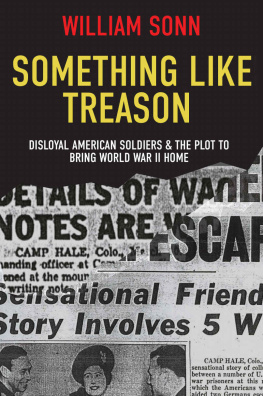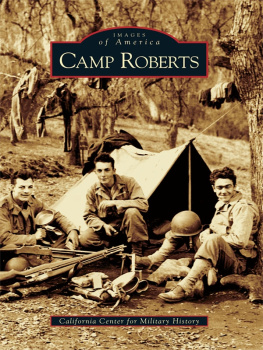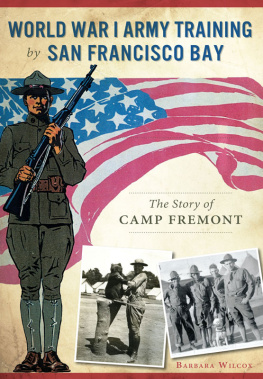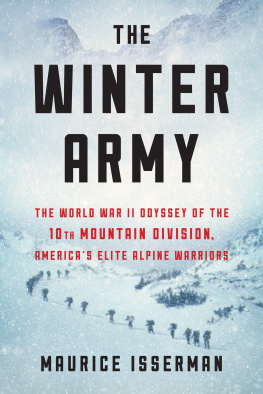


Published by The History Press
Charleston, SC
www.historypress.net
Copyright 2015 by David R. Witte
All rights reserved
First published 2015
e-book edition 2015
ISBN 978.1.62585.608.1
Library of Congress Control Number: 2015947678
print edition ISBN 978.1.46711.854.5
Notice: The information in this book is true and complete to the best of our knowledge. It is offered without guarantee on the part of the author or The History Press. The author and The History Press disclaim all liability in connection with the use of this book.
All rights reserved. No part of this book may be reproduced or transmitted in any form whatsoever without prior written permission from the publisher except in the case of brief quotations embodied in critical articles and reviews.
CONTENTS
FOREWORD
During those first few, frightening months of Americas involvement in World War II, there were hundreds of military camps, bases and posts that sprang up all across the nation practically overnight. Young men (and women, too) had to be quickly converted from civilians to soldiers, sailors, airmen and marines.
Most of these newly created camps were utilitarian in the extreme, with cookie-cutter wooden barracks, headquarters buildings, hospitals, training facilities and recreational centers emerging from fields, swamps, deserts and forestswherever the government could purchase a few hundred thousand acres of otherwise little-used land.
One of the most unusual of these camps suddenlyfrom April to November 1942appeared 9,250 feet up in the Colorado Rocky Mountains. It was named Camp Hale and, from mid-1942 until the summer of 1944, would be the home of Americas only army division specially trained for mountain and winter warfare: the 10th Mountain Division.
Located on U.S. Highway 24 between the Colorado towns of Minturn and Leadville and one hundred mountainous miles west of Denver, Camp Hale offered the kind of terrain perfect for training men to live and fight in an inhospitable environment. (The war had already involved heavy fighting in some of the coldest and most mountainous areas of Europe.)
An army of ten thousand workmen spent those eight months in a massive wartime construction projectdraining the high-meadow swamp; removing the thick undergrowth of foliage; straightening the twisting Eagle River; rerouting Highway 24; putting in roads, streets, water and sewage facilities and power plants; adding railroad spurs to the warehouse area; and building a rifle range, a combat village, an artillery range, two ski-training areas and much, much more. All told, there were more than eight hundred structures of every description that were erected in this, the highest of all U.S. Army posts. In addition, there were barns and stables and veterinary facilities to house and take care of some four to five thousand pack mules and horses that the division would need to haul artillery and supplies into the trackless mountains.
Once the camp began to take shape, into this wilderness locationwhere the air is thin and the snow on the surrounding peaks never meltspulled hundreds of troop trains carrying thousands of young men who had either volunteered or had been drafted into the ski troops. The training was impossibly hard. During the winter, there was skiing (cross-country and downhill) from morning until night. In the summer, there were long marches and rock-climbing drills that tested the soldiers stamina and courage. All year long, there was unending physical conditioning in the thin air and exercises designed to teach survivalist skills and turn flabby city boys into rock-hard mountain soldiers capable of defeating a ruthless enemy in some of the most difficult environments on earth.
Until now, the story of Camp Hale has been told piecemeal in various publications and documentary films. David Witte has performed a great service for all history buffs by creating this fascinating, richly detailed and thoroughly researched portrait of a unique place. Drawing on a considerable amount of original source material and locating scores of photographs that have rarely, if ever, been published, he has woven together a narrative of an army camp that served America for only a brief time but that has gone down in legend.
He has also done what few writers have done: turn a geographic location into a living, breathing entity.
So bundle up, put on your mukluks and fur-lined parka, wax your boards, grab a canteen full of hot joe and immerse yourself in a read that will take you on a journey to a chilly, windswept place that today exists only in memory but that is imbued with glory brought to it by the greatest generation.
FLINT WHITLOCK
10th Mountain Division descendant and coauthor of Soldiers on Skis: A Pictorial Memoir of the 10th Mountain Division
PREFACE
Sitting in the barren, flat and compressed land of the Eagle Valley, just north of the Continental Divide in the Sawatch Range of the Colorado Rocky Mountains, are the remnants of a once bustling and booming army cantonment. The roar of steam engines and train whistles are all but silenced, and the firing of M1 rifles is a distant thought of the past. No more calling of cadence and singing of songs remains as the land glimmers in the cool mountain air and gleaming summer sun. However, small signs on the side of Highway 24, which one can miss in the blink of an eye, share a brief glimpse into the past of this majestic land and the wartime activities that once rumbled the valley. The remaining concrete foundations and support beams presently on the land reveal little about the story of the tens of thousands of men and women who served and trained at Camp Hale during the years of World War II. While various other information plaques around the valley help the casual visitor envision a city of white barracks and other buildings, much of the history of the area has been untold. What remains is a true American story of ingenuity, determination, racial conflict and overcoming adversity to obtain something never done before. The history of the cantonment is a worthy story to be told due to the significant social and economic impact the camp had on its workers, the nearby Arkansas River Valley of Colorado, the armys future cantonment development and the mountain and ski troopers who were stationed there. This is the untold story of Camp Hale, Colorado.
The land of the Eagle Valley has intrigued me ever since I was a eight-year-old boy riding through the Rocky Mountains on Highway 24 on one of my annual summer family vacations to Colorado. Every summer we packed up the minivan and drove the 1,040-mile, fifteen-hour trip from Lombard, Illinois, to Monument, Colorado, to visit family and to enjoy the mountains. For our family, vacations were never about getting away but rather about getting to the mountains. The Colorado Rockies have always interested me, with their majestic peaks at elevations above fourteen thousand feet, higher than most Americans will ever see and feel unless driving up to the top of Pikes Peak or Mount Evans. I began climbing the fourteeners at the age of nine and have not stopped since. The combination of the adventure and the history that lies within these rugged mountains is something that keeps drawing me back. Though I had completed all fifty-four fourteeners by the summer of 2015, Colorado remains a yearly destination for my family.
Next page













